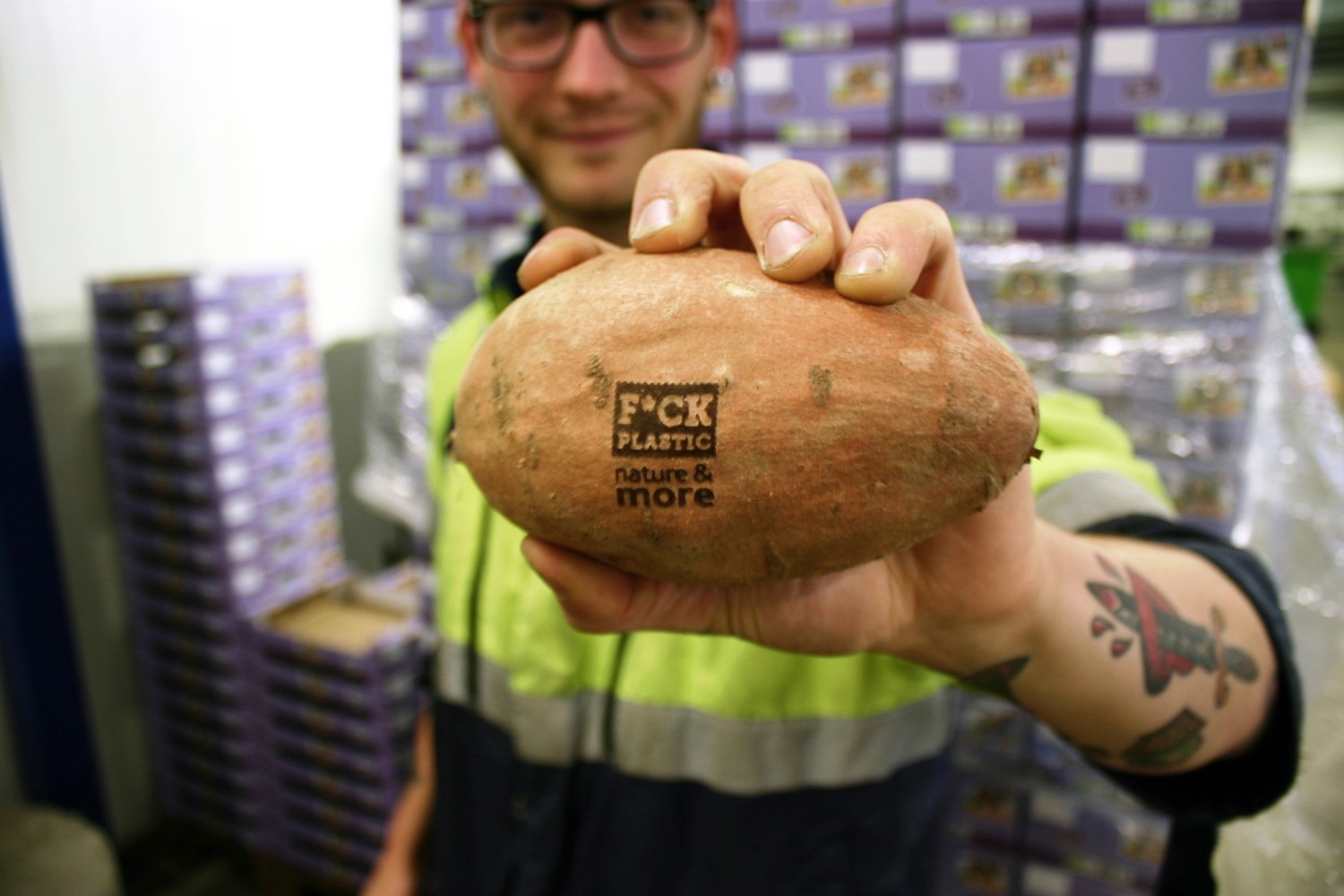Quick Links
You probably noticed that stickers are everywhere, on bananas, on apples, on the back of cars, on laptops and on your mail. But do you think they are biodegradable or compostable? Most of them aren’t, but that is not to say that there are some eco-friendly stickers that can handle all your sticker requirements.
Thankfully as we all become more aware of the health of our planet, more and more businesses are going green and putting in their best efforts to lead this movement. And as minuscule as these stickers seem, they often end up as microplastic, polluting our water ways marine life and we even consume some of this. More on that later.
So what are the alternatives? Can we use laser technology instead of stickers and perhaps burn the desired label or image into the product? Let’s take a look.
What stickers are eco-friendly?
Here are some of the best environmentally friendly stickers that are biodegradable and compostable to TUV standards. Meaning you can throw them into your home compost without contaminating it.
We got you if you are a shop owner looking for environmentally friendly stickers.
In my research, I made sure that the stickers you buy are going to have a high print quality, come in eco-friendly packaging, are highly customizable and have a small environmental impact.
The best alternative to traditional stickers

Natural Branding where possible
Yes, this might only apply to fruit and vegetables to differentiate from organic and non-organic produce, but it can make a massive dint in the way we use and throw out plastic stickers. This way doesn’t damage the produce, and it looks good too. You can learn more about this method and how much plastic is being prevented from going into landfills here.
Recycled paper stickers
Ecoenclose is one company making not only an uncoated recycled paper sticker or label for all your shipping and design needs. But what they also have developed is the first zero waste release liner. Made from post-consumer waste and it is 100% curbside recyclable.
They are actually saying that more than 60 billion release liners are being dumped in our landfills yearly and that the market share of release liners is 20 billion. Pretty crazy for something that we throw out right?
They have free offer samples of their eco-friendly stickers, and you can create custom stickers that work well with your eco-friendly brand.
Features:
The stickers are only recyclable when placed on a paper corrugated surface and the sticker and surface will be recycled in the same stream.
No protective coating means not waterproof (best for Paper and cardboard goods, Ecobands, tissue paper, glassine bags, and items with light exposure such as notebooks and dry food packaging).
Stickers come delivered on the zerowaste liner.
Facestock – 100% post-consumer waste paper in white
Printing Ink – UV ink or toner depending on liner and delivery method
Noissue Stickers/
Noissue paper Stickers are made with FSC-certified materials and soy-based inks. These stickers are 100% recyclable and compostable and come in a range of sizes and shapes. I didn’t find anything about the label backing which is this silky-looking paper that you peel your stickers off it. Often this is made from a non-recyclable material.
Wood Stickers
Dust city wood stickers is a company operating out of the US that only uses FSC-certified wood for its products. These stickers are 100% biodegradable and when used indoors last just as long as your average vinyl stickers.
However, they only last up to two years when left outside or washed in the dishwasher, according to their website.
The packaging is also eco-friendly as each sticker comes in a cellophane sleeve, which is biodegradable and not adding to the micron plastic tragedy if it was made from plastic.
Those are pretty much all the options I have come across that fit my criteria for eco friendly stickers.
What are stickers made of?
What may look like paper is often a type of plastic. The most common is the vinyl sticker made from PVC or polyvinyl chloride. It is waterproof and very durable; it can come in many colors or even transparent. It works for most applications which makes it a great solution for stickers. The downside is that PVC is one of the most toxic plastics and is not biodegradable or compostable. Greenpeace dubbed it the POISON PLASTIC, and if you would like to learn more about it, you can here.
1. Vinyl stickers.
Vinyl is a plastic known to be the most toxic to humans and the environment. Vinyl stickers are not biodegradable and pose a big threat to our health. Creating vinyl starts by extracting crude oil from the earth and turning it into vinyl by adding a salt. It doesn’t sound too bad, right? Well, it is highly energy intensive and results in a product known to be the most toxic plastic containing phthalates that are known cancer-causing chemicals.
Vinyl is used in kids’ toys, which is shocking, hence why you can find safe kid’s toys in this article. Besides vinyl records, it is also used in electrical components and building components.
2. Polyester stickers
Polyester is another material that can be used to make stickers. Often for outdoor use, these stickers are very durable and waterproof. They can be used to label glass bottles and windows. In addition to not being recyclable, it is also not environmentally friendly.
3. Polypropylene Stickers
They are often used because of their durability to withstand the harshest conditions like chemicals and weather. They are chemical and oil-resistant but not waterproof, only water-repellent. You will find them in clear, white or silver, giving you a metallic look.

What are stickers used for?
It is common for people to use stickers to decorate things such as their laptops or to show off how many kids they have by putting them on the rear window of their car.
While the number of stickers in the world is in the trillions, I wanted to talk about them since they also contribute to the microplastic problem we are currently facing.
If you haven’t heard about it, check out this article and be in the know.
Alternatively, you can subscribe to our newsletter here and get some handy tips in your mailbox.
Are plastic stickers recyclable?
As much as I would like to say yes, the answer is no. It is too complicated to collect and sort all the different labels, so they end up in incinerators or in landfills. Stickers are usually designed for one-time use which does not fit into a circular economy. Traditional stickers like the ones you can buy at your Walmart or Superstore are generally made from plastic and are not recyclable.
Although certain types of plastic can be recycled most of them don’t get recycled, because of the glue that is being used. This will leave a chemical residue behind and cleaning each sticker would cost a fortune, so no go. Sadly they add to the microplastic tragedy.
What about the paper a sticker adheres to?
This paper is called backing paper or release liner and is generally made from virgin paper.
The release liner in most cases is lined with silicone, PET (Polyethylene terephthalate), or PP (Polypropylene)making it unrecyclable. These plastics allow the stickers to easily peel off the paper without losing the ability to stick to the next thing.
Is their compostable backing papers?
The simple answer is no. I haven’t seen an article on the web claiming their backing paper is compostable or recyclable.
Additionally backing paper is a form of paper called glassine that is very low quality since the paper fibers are being flattened and aligned in the same direction making for a very smooth touch but basically turning it into something unrecyclable.
Then companies add the coating on the release liner which is difficult to remove and often not clear which type of plastic you are dealing with, this all becomes a very costly way to recycle, hence it is just discarded.
High processing costs and low material value are the two biggest challenges to recycling, which makes it easy to understand why this product is rarely accepted for recycling. (source)
Can stickers be environmentally friendly?
Yes, stickers can be made with environmentally friendly materials such as wood, paper and cellulose (as mentioned above), which is harvested in FSC-certified forests and is the best renewable eco-friendly source. Often the backing of stickers is a whole other problem and I have only come across eco encloses zero waste liner that is curbside recyclable and made from recycled material but is it zero waste?
What about compostable stickers?
A few companies, like Dust City, make fully home compostable stickers, which means they are safe to be thrown into your compost at home or if sent to a composting facility they will also degrade and turn back into soil.
Be careful when looking for eco-friendly stickers, because the regulations around the words biodegradable and compostable aren’t very strict, meaning marketers are using these terms lightly to make them sound green and boost profits and sell more products.
Bioplastics often fall under this category since they are made with biomaterials, aka corn or sugarcane, but the end product is non-biodegradable bio-plastic. It sounds good but only biodegrades when it ends up in a composting facility with the right conditions for several days.
Is Sticker Mule eco-friendly?
This is a question that keeps popping up, and from the research, I have conducted on their website there are no claims of any sort that could make sticker mule an eco-friendly company.
Usually what I would look for is that they have a dedicated page to sustainability and then that they are also very transparent about where the product is made under which labor laws and do they have any certifications like B Crorp or perhaps a 1% member of the planet certificate. I could not find anything, so I suggest you look for other companies for your sticker needs.
Can you eat fruit stickers?
If you have ever bitten into an apple and accidentally chewed up a piece of fruit sticker make sure to spit it out again, because whatever you may find on the internet saying the fruit stickers are FDA-approved and considered edible isn’t actually the case. Most stickers are made of some plastic, so essentially you are eating a bit of plastic, which in my books doesn’t belong in my body.
As an alternative presented back in 2015 was laser labels. Which is a laser edging a label into the skin of the fruit without damaging the skin too deep so bacteria could enter the fruit. This was welcome by supermarkets and farmers because it would stop label swapping by customers to save money on organic fruit( yep, apparently that s a thing) and the fruit can be traced back which if the sticker comes off wasn’t possible. (not sure why you need that).
Final thoughts
I hope this answers all your eco friendly sticker questions for your business or simply just for the joy of decorating your stuff. If you have come across some brands that I haven’t mentioned and you think they should be on this list, feel free to leave a comment below.
